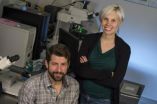(Press-News.org) Who would you rather have as a fitness partner: a paragon of athleticism and dedication who could motivate you to exceed your current level of fitness or an equal, with whom you could exchange tips and encouragement on the road to better health?
Or neither? According to a new study led by University of Pennsylvania's Damon Centola, participants in an online fitness program ignored the fitness aptitude of their potential partners.
"Instead they chose contacts based on characteristics that would largely be observable in regular, offline face-to-face networks: age, gender and body mass index," Centola said.
As more people turn to the Internet to help them improve their health and fitness, Centola, an associate professor in the Annenberg School for Communication, wanted to examine how people sought out health partners in an online forum. He coauthored the study with Arnout van de Rijt, an associate professor in Stony Brook University's Department of Sociology. The paper was published online earlier this month in the journal Social Science and Medicine.
Centola and van de Rijt partnered with an existing online fitness website to recruit 432 participants to be part of their new "Health Improvement Network." All of the participants shared ten pieces of information: their age, gender, ethnicity, body mass index (BMI), fitness level, diet preferences, goals for the program and favorite exercise, as well as their average exercise minutes and intensity level.
The researchers divided the participants into six groups. Each participant was then randomly partnered with six "health contacts" in their group with whom they could exchange information. Over a five-week period, the participants were given the opportunity to select new health contacts and drop existing ones. The only information on which they had to base their choice was the set of ten characteristics that the other members of the group had shared. Participants had no knowledge of who each other's health contacts were, or whether there were any "highly connected" individuals. This allowed the study to reveal which characteristics participants would use to make their connections.
The researchers anticipated that group members would select health contacts who shared similar exercise routines or interests, or even fitness "leaders" who were very fit and could serve as motivational role models. Yet in five of the six communities, participants did neither. Rather, the community members showed a strong inclination to choose contacts whose age, BMI and gender were like their own.
The participants' tendency to "make ties to 'the devil they know,'" the authors wrote, "may unintentionally limit their opportunities for finding health information from sources that they are not normally exposed to."
The findings suggest that although people in online health programs are beckoned with the possibilities of meeting healthier people who can provide them with information about new kinds of exercises and better strategies for getting healthy, they self-select into networks that look very similar to the kinds of networks that people typically have offline: people with similar age, gender and BMI profiles as themselves.
Health programs can work around this human tendency, Centola noted, by actively recommending "health buddies" based on characteristics that are hard to connect to offline, but easy to find online, such as people who are good motivational partners, or partners who prefer similar exercises, or are working to increase their endurance to similar levels.
"Our findings suggest that the trick to an information-rich online community," Centola said, "is to encourage new kinds of ties by reminding participants just how valuable these online relationships can be."
INFORMATION:
The research was supported by the James S. McDonnell Foundation, the MIT Research Support Committee and the National Science Foundation.
Demographics drive fitness partner decisions online, Penn study finds
2014-06-05
ELSE PRESS RELEASES FROM THIS DATE:
New tuberculosis test more than skin deep
2014-06-05
A new screening process for tuberculosis (TB) infections in Canadian prisons could mean that more than 50 per cent of those screened won't undergo unnecessary treatment due to false positives.
According to research by Wendy Wobeser and medical resident Ilan Schwartz, a test for TB using interferon-gamma release assays (IGRA) will detect a pre-existing TB infection, or latent TB, that might not present itself for many years, or until the body becomes weakened by another source.
"It's fairly uncommon that latent TB will reactivate – only about a 10 per cent chance," says ...
Seemingly invincible cancers stem cells reveal a weakness
2014-06-05
CAMBRIDGE, Mass. (June 5, 2014) – Metastatic cancer cells, which can migrate from primary tumors to seed new malignancies, have thus far been resistant to the current arsenal of anticancer drugs. Now, however, researchers at Whitehead Institute have identified a critical weakness that actually exploits one of these cells' apparent strengths—their ability to move and invade tissues.
"This is the first vulnerability of invasive cancer cells that we really understand," says Whitehead Member Piyush Gupta, whose lab's latest work is described in the June issue of the journal ...
New evidence links air pollution to autism, schizophrenia
2014-06-05
A new study published in the journal Environmental Health Perspectives describes how exposure to air pollution early in life produces harmful changes in the brains of mice, including an enlargement of part of the brain that is seen in humans who have autism and schizophrenia.
As in autism and schizophrenia, the changes occurred predominately in males. The mice also performed poorly in tests of short-term memory, learning ability, and impulsivity.
The new findings are consistent with several recent studies that have shown a link between air pollution and autism ...
New findings out on brain networks in children at risk for mental disorders
2014-06-05
DETROIT – Attention deficits are central to psychiatric disorders such as schizophrenia or bipolar disorder, and are thought to precede the presentation of the illnesses. A new study led by Wayne State University School of Medicine researcher Vaibhav Diwadkar, Ph.D. suggests that the brain network interactions between regions that support attention are dysfunctional in children and adolescents at genetic risk for developing schizophrenia and bipolar disorder.
"The brain network mechanisms that mediate these deficits are poorly understood, and have rarely been tackled ...
Rice developing mobile DNA test for HIV
2014-06-05
Rice University bioengineers are developing a simple, highly accurate test to detect signs of HIV and its progress in patients in resource-poor settings.
The current gold standard to diagnose HIV in infants and to monitor viral load depends on lab equipment and technical expertise generally available only in clinics, said Rice bioengineer Rebecca Richards-Kortum. The new research features a nucleic acid-based test that can be performed at the site of care.
Richards-Kortum, director of the Rice 360˚: Institute for Global Health Technologies, and her colleagues reported ...
Iowa State, Ames Lab researchers find the mechanism that forms cell-to-cell catch bonds
2014-06-05
AMES, Iowa – Certain bonds connecting biological cells get stronger when they're tugged. Those bonds could help keep hearts together and pumping; breakdowns of those bonds could help cancer cells break away and spread.
Those bonds are known as catch bonds and they're formed by common adhesion proteins called cadherins. Sanjeevi Sivasankar, an Iowa State University assistant professor of physics and astronomy and an associate of the U.S. Department of Energy's Ames Laboratory, has described catch bonds as "nanoscale seatbelts. They become stronger when pulled."
But how ...
Short nanotubes target pancreatic cancer
2014-06-05
Short, customized carbon nanotubes have the potential to deliver drugs to pancreatic cancer cells and destroy them from within, according to researchers at Rice University and the University of Texas MD Anderson Cancer Center.
Pristine nanotubes produced through a new process developed at Rice can be modified to carry drugs to tumors through gaps in blood-vessel walls that larger particles cannot fit through.
The nanotubes may then target and infiltrate the cancerous cells' nuclei, where the drugs can be released through sonication – that is, by shaking them.
The ...
LSU biologist James Caprio, Japanese colleagues identify unique way catfish locate prey
2014-06-05
BATON ROUGE – Animals incorporate a number of unique methods for detecting prey, but for the Japanese sea catfish, Plotosus japonicus, it is especially tricky given the dark murky waters where it resides.
John Caprio, George C. Kent Professor of Biological Sciences at LSU, and colleagues from Kagoshima University in Japan have identified that these fish are equipped with sensors that can locate prey by detecting slight changes in the water's pH level.
A paper, "Marine teleost locates live prey through pH sensing," detailing the work of Caprio and his research partners, ...
Termites, fungi and climate change
2014-06-05
Climate change models could have a thing or two to learn from termites and fungi, according to a new study released this week.
For a long time scientists have believed that temperature is the dominant factor in determining the rate of wood decomposition worldwide. Decomposition matters because the speed at which woody material are broken down strongly influences the retention of carbon in forest ecosystems and can help to offset the loss of carbon to the atmosphere from other sources. That makes the decomposition rate a key factor in detecting potential changes to the ...
Brazil leads the world in reducing carbon emissions
2014-06-05
As the world turns its attention to Brazil with the opening of the World Cup this month, many people around the globe know the country's soccer fame, but few realize that it is the world's leader in reducing carbon emissions. A new study published in Science magazine provides the first in-depth analysis of how Brazil reached this global-leader status and managed to increase its agriculture production at the same time.
"Brazil is known as a leading favorite to win the World Cup, but they also lead the world in mitigating climate change," says the study's lead author, ...



